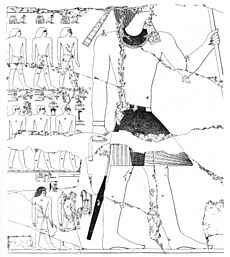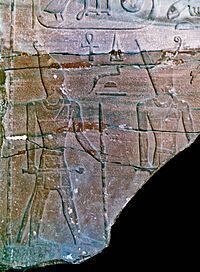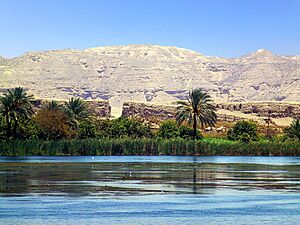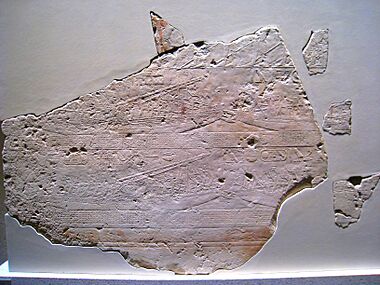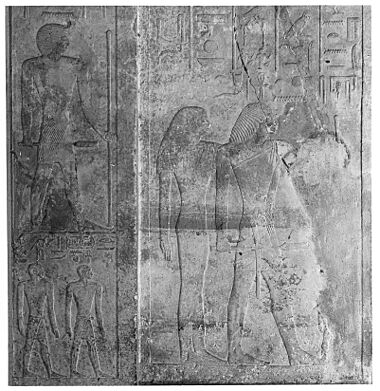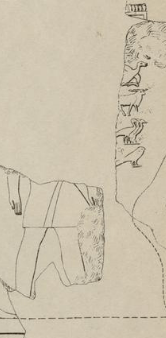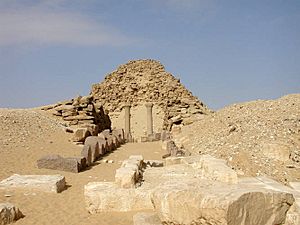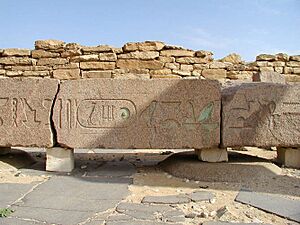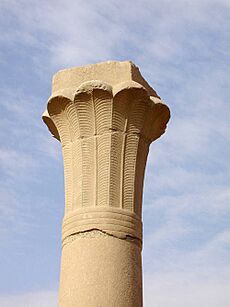Sahure facts for kids
Quick facts for kids Sahure |
|
|---|---|
| Sahura, Sahu-Re, Sephrês, Σϵϕρής | |
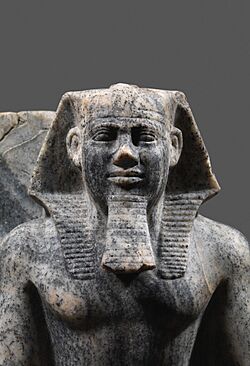
Head of a gneiss statue of Sahure in the gallery 103 of the New York Metropolitan Museum of Art.
|
|
| Pharaoh | |
| Reign | Duration: 13 years, 5 months and 12 days in the early 25th century BC (Fifth Dynasty) |
| Predecessor | Userkaf |
| Successor | Neferirkare Kakai |
| Consort | Meretnebty |
| Children | Ranefer ♂ (ascended the throne as Neferirkare Kakai), Netjerirenre ♂ (possibly the same person as Shepseskare), Horemsaf ♂, Raemsaf ♂, Khakare ♂ and Nebankhre ♂ |
| Father | Userkaf |
| Mother | Neferhetepes II |
| Burial | Pyramid of Sahure |
| Monuments | Pyramid of Sahure "The Rising of the Ba Spirit of Sahure" Sun temple "The Field of Ra" Palaces "Sahure's splendor soars up to heaven" and "The crown of Sahure appears" |
Sahure (also called Sahura) was an important pharaoh of ancient Egypt. His name means "He who is close to Re". He was the second ruler of the Fifth Dynasty, which lasted from about 2465 to 2325 BC. Sahure ruled for about 13 years in the early 25th century BC, during Egypt's Old Kingdom Period. His time as pharaoh was a high point for the Fifth Dynasty, both politically and culturally.
Sahure was likely the son of the pharaoh Userkaf and Queen Neferhetepes II. After Sahure, his son Neferirkare Kakai became the next pharaoh.
During Sahure's rule, Egypt had strong trade connections with countries along the Mediterranean Sea, like modern-day Lebanon. He sent many ships to Lebanon to get valuable cedar wood, and other special items. Egypt's navy grew strong under Sahure, with large ships for the open sea and fast racing boats. He even sent the first recorded trip to the distant land of Punt, bringing back lots of myrrh, malachite, and electrum. A carving in his temple shows him planting a myrrh tree, which is the only time an Egyptian king is shown gardening.
Sahure also sent teams to the turquoise and copper mines in Sinai. He led military attacks against Libyan leaders in the Western Desert, bringing back many animals to Egypt.
Sahure built his pyramid in Abusir, instead of the usual royal burial sites like Saqqara and Giza. This might have been because Userkaf's sun temple, the first of its kind in the Fifth Dynasty, was in Abusir. Sahure's pyramid is smaller than those from the earlier Fourth Dynasty. However, the art and design of his temple are much more detailed and beautiful. His temple complex was decorated with over 10,000 square meters of colorful carvings, showing the best art of the Old Kingdom. Sahure's builders also started using columns shaped like palm leaves, which became a common feature in Egyptian buildings. The design of his temple also set a new standard for other temples built during the Old Kingdom. Sahure also built a sun temple called "The Field of Ra", but its exact location is still unknown.
After his death, people continued to honor Sahure. Food offerings for his cult were provided by farms set up during his reign. This official worship lasted until the end of the Old Kingdom. Later, during the Middle Kingdom, Sahure was seen as an important ancestor, but his cult no longer had special priests. In the New Kingdom, Sahure was linked to a form of the goddess Sekhmet for reasons we don't know. The cult of "Sekhmet of Sahure" had priests and drew visitors from all over Egypt to his temple. This unusual cult continued for almost 2500 years after Sahure died, lasting until the end of the Ptolemaic period.
Contents
Sahure's Family Life
Who Were Sahure's Parents?
Recent digs at Sahure's pyramid in Abusir have helped us learn about the royal family of the early Fifth Dynasty. Carvings from his pyramid complex show that Sahure's mother was Queen Neferhetepes II. She was the wife of pharaoh Userkaf. Her pyramid is right next to Userkaf's, and she was called "king's mother." This strongly suggests that Userkaf was Sahure's father. Also, Sahure's royal name was found in Userkaf's temple, meaning Sahure likely finished the building his father started.
This new information goes against older ideas that Sahure was the son of Queen Khentkaus I. She was thought to be the wife of Shepseskaf, the last pharaoh of the Fourth Dynasty.
Sahure's Children
Sahure was followed by Neferirkare Kakai. Until 2005, people thought Neferirkare Kakai was Sahure's brother. But in 2005, a carving from Sahure's pyramid was found. It showed Sahure with two of his sons, Ranefer and Netjerirenre. Next to Ranefer's name, it said "Neferirkare Kakai king of Upper and Lower Egypt." This showed that Ranefer was Sahure's son and became pharaoh after his father died, using the name Neferirkare Kakai.
Since both Ranefer and Netjerirenre were called "king's eldest son," some experts think they might have been twins, with Ranefer born first. They also suggest that Netjerirenre might have briefly become pharaoh as Shepseskare, but this is just a guess. The same carving also shows Queen Meretnebty, who was likely Sahure's wife and the mother of Ranefer and Netjerirenre. Three more sons, Khakare, Horemsaf, and Nebankhre, are shown in Sahure's temple, but we don't know who their mother was.
Netjerirenre held several important religious titles, suggesting he had a high position in the royal court. Some think he might have been a vizier (a top official) for his father. However, this is debated because royal princes were starting to be excluded from the vizier position around Sahure's time.
Sahure's Time as Pharaoh
How Long Did Sahure Rule?
We know the order of Sahure's rule very well from old records and artifacts. He came after Userkaf and before Neferirkare Kakai. An ancient history book called the Aegyptiaca, written around 300 BC, also confirms this order. It mentions "Usercherês → Sephrês → Nefercherês," which are the Greek names for Userkaf, Sahure, and Neferirkare.
Other king lists, like the Abydos king list and the Saqqara Tablet, also show Sahure in the correct order. These lists were made much later, during the reigns of Seti I and Ramses II.
The Turin canon, another old list from the 19th Dynasty, says Sahure ruled for 12 years, 5 months, and 12 days. The Palermo Stone, a royal record from Sahure's time, mentions his second, third, fifth, sixth, and even his 13th or 14th year. It also records the day he died. Putting this information together, it seems Sahure ruled for 13 years, 5 months, and 12 days. This is very close to the 13 years mentioned in the Aegyptiaca.
Sahure's exact dates are not certain, but most experts place his rule in the first half of the 25th century BC.
Egypt's Foreign Relations
Trade and Resources
Records and artifacts show that Egypt had many contacts with other lands during Sahure's reign. Most of these contacts were for trade, not war. Carvings from his pyramid complex show ships returning from Lebanon, filled with valuable cedar tree trunks. Other ships are shown with "Asiatics" (people from Asia), both adults and children, who were likely traders or slaves. They are shown greeting Sahure, saying:
Hail to thee, O Sahure! God of the living, we behold thy beauty!.
This carving also suggests that interpreters were on the ships to help with trade.
A unique carving in Egyptian art shows several Syrian brown bears. These bears were likely brought from the Mediterranean coast by ship, along with 12 red jars from Syria. Experts think the bears and jars were a tribute (a payment) from another land.
Trade with Byblos (a city in modern-day Lebanon) also happened during Sahure's rule. An alabaster bowl with Sahure's name was found in the temple of Baalat-Gebal in Byblos. The design of this temple might even have been influenced by Sahure's temple in Egypt. Many stone pots with the names of Fifth Dynasty pharaohs have been found in Lebanon, showing strong trade links. One expert, Gregory Mumford, says Sahure is the "best attested king for international relations."
In his last year, Sahure sent the first recorded trip to the famous land of Punt, probably along the coast of Somalia. The Palermo Stone says this trip returned with large amounts of myrrh, malachite, electrum, and wooden staffs (possibly ebony).
Sahure also sent another trip to the copper and turquoise mines in Wadi Maghareh and Wadi Kharit in Sinai. These mines had been used since the Third Dynasty. This trip, also mentioned on the Palermo Stone, brought back over 6,000 units of turquoise. Two carvings in Sinai show Sahure defeating people from Asia. One carving says, "The Great God smites the Asiatics of all countries." Also, diorite quarries near Abu Simbel were used throughout Sahure's reign.
Military Actions
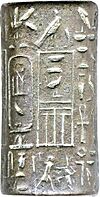
We learn about Sahure's military actions mainly from carvings in his temple. He seems to have led campaigns against Libyans from a land called Tjemehu, possibly in the northern Western desert. These campaigns supposedly brought back huge numbers of animals, and Sahure is shown defeating local leaders. However, it's hard to know if these scenes are historically accurate. Such images were often used to show the king's power. The same scene of a Libyan attack was used much later by other pharaohs. So, Sahure might have been copying an even older image.
Even so, Sahure did appoint officials to oversee the Western Nile Delta region. This was important because these officials helped control traffic across the border between Egypt and Libya. At the same time, Sahure's temple has the earliest known mention of pirates attacking the Nile Delta.
Carvings in Sahure's temple show the god Ash promising the king control over all lands and riches around Egypt. This shows Sahure's ambition to control foreign territories.
What Sahure Did in Egypt
Religious Activities
Most of Sahure's activities in Egypt, as recorded on the Palermo Stone, were religious. In his first year, he traveled to the Elephantine fortress. There, he might have received the loyalty of Nubian chiefs in a special ceremony. The stone also mentions the creation of six statues of the king and the "opening of the mouth ceremonies" for them.
In Sahure's fifth year, the Palermo Stone mentions building a divine boat, possibly in Heliopolis. It also records the appointment of 200 priests and the exact amounts of daily offerings (bread and beer) to gods like Ra, Hathor, Nekhbet, and Wadjet. The king also gave land to temples. The stone also has the earliest known mention of the city of Athribis in the Nile Delta.
Sahure was the first known king to use the title Nb írt-ḫt, meaning "Lord of doing effective things." This title suggests he personally took part in religious acts to keep Maat (Egypt's idea of order and justice) alive. This title was used for another 1500 years. Sahure's reign also saw the first known "driving of the calves" ceremony. This ceremony later became a key part of the Osiris myth, where it represented Seth's actions against Osiris.
Sahure also reorganized the worship of his mother, Nepherhetepes II. He added an entrance to her temple so it no longer faced Userkaf's pyramid.
Building and Mining
Sahure's building projects were mainly in Abusir. He built his pyramid there, and his sun temple is probably also in that area. His palace, called Uetjes Neferu Sahure ("Sahure's splendor soars up to heaven"), is known from an inscription found in another temple. A second palace, "The Crown of Sahure appears," is mentioned in the tomb of his chief doctor. Both palaces were likely near the Abusir lake.
The stones for Sahure's buildings and statues came from all over Egypt. For example, the limestone for his pyramid came from Tura. The black basalt for his temple floor came from Gebel Qatrani, near the Faiyum in Middle Egypt. A stone slab with Sahure's name was found in diorite quarries near Abu Simbel in Lower Nubia.
Other mining trips can be guessed from clues. An inscription of Sahure in the Wadi Abu Geridah suggests that iron ore was mined there since the Fourth Dynasty. A statue piece with Sahure's name was found in Elkab, a place linked to trips to the Eastern desert and Nubia. Sahure's name has also been found in graffiti in Tumas and on seals from Buhen in Lower Nubia.
Sahure's reign might have been a time when the Egyptian navy grew stronger. His trips to Punt and Byblos show that Egypt had ships capable of sailing on the open sea. Carvings from his temple are the "first clear pictures of seagoing ships in Egypt," some of which were about 50 meters (170 feet) long.
Because of this, some experts used to say Sahure started the Egyptian navy. However, we now know that ships existed much earlier. But Sahure is the earliest known ruler to show ships being used to carry soldiers across the Mediterranean Sea to Syria.
The detailed ship scenes from Sahure's temple show that special racing boats were built for the military and for ceremonies. They also show the earliest use of specific ropes on ships, like a "hogging-truss" (a rope that helps support the ship's structure). These carvings give us clues about shipbuilding. For example, they show that the side of the ship above the water was about 1 meter (3 feet) high, and that the masts were shaped like an upside-down Y. Other rare carvings show the king standing in a boat with a decorated sail, and men paddling in a wave pattern, possibly during a race.
Life at Court
Important Officials
We know about several important officials who served Sahure from their tombs and from the king's temple. Niankhsekhmet, Sahure's chief doctor and the first known nose doctor in history, said that he asked the king for a false door for his tomb. The king agreed and had the false door made from fine Tura limestone, carved and painted blue in his audience hall. The king even checked the work himself every day. Sahure wished his doctor a long life, saying:
As my nostrils enjoy health, as the gods love me, may you depart into the cemetery at an advanced old age as one revered.
A similar story, though less detailed, is told by Khufuankh, who was the overseer of the palace and the king's singer.
Other officials included Hetepka, who managed the king's crown and hairdressers. Pehenewkai was a priest of Userkaf's cult during Sahure's reign, and later became a vizier. Persen was a priest in the cult of Sahure's mother. Washptah was a priest of Sahure, then a vizier for Neferirkare Kakai. The high official Ptahshepses, who was a high priest of Ptah and royal manicure under Sahure, was later promoted to vizier by Nyuserre Ini.
Two viziers of Sahure are known: Sekhemkare, a royal prince and son of Khafre, who was vizier under Userkaf and Sahure. The other was Werbauba, who served as vizier during Sahure's reign.
Changes in High Offices
Sahure continued Userkaf's policy of giving high government jobs to people who were not part of the royal family. This is clearest with the vizier position. Before, only royal princes could be viziers. But by Sahure's time, princes were slowly being excluded from this top job. This change was likely linked to changes in how kingship was seen. This process seems to have finished by Sahure's time, as no royal prince became vizier after him. Those who were already viziers were allowed to keep their jobs. So, at the start of Sahure's reign, Vizier Sekhemkare was a "King's son," but his successor, Werbauba, seems to have been non-royal. Because of this change, the government grew as more non-royal people joined.
At the same time, new ideas for decorating tombs of private individuals appeared during Sahure's reign. These included special moldings and cornices for false doors, first seen in Persen's tomb. This shows how highly Persen was regarded by the king. Another new idea was showing small, unusual offerings, like seven sacred oils, on false doors. This was first seen in Niankhsekhmet's tomb. The official list of offerings also developed around Sahure's time, first in royal tombs, then spreading to tombs of non-royal officials.
Sun Temples of Sahure
The Field of Ra
Sahure built or started building a temple for the sun god Ra. This was the second such temple of the Fifth Dynasty. We know it existed from an inscription on the Palermo Stone, where it's called Sekhetre ("The Field of Ra"). It's also mentioned in 24 tombs of officials. A few limestone blocks from the temple were found in the walls of Nyuserre Ini's temple, Sahure's fourth successor. This might mean these blocks were leftover, or that Nyuserre took apart Sahure's temple for building materials because it was not finished. Indeed, there's not much evidence for Sekhetre, leading some experts to think it never fully worked as a sun temple.
New studies of the Palermo Stone in 2018 showed more inscriptions about the temple's design and gifts it received. This confirms it was a separate temple from Userkaf's earlier sun temple, but its final fate is still unclear.
Fortress of Re
Userkaf was the first king to build a sun temple in Abusir. It was called the Nekhenre, or "Fortress of Re," and was not finished when he died. Building continued in at least four stages, with work possibly done under Sahure and then his successors Neferirkare Kakai and Nyuserre Ini.
Sahure's Pyramid Complex
Sahure built a pyramid complex for his tomb and religious ceremonies. It was called Khaba Sahura, which means "The Rising of the Ba Spirit of Sahure" or "In glory comes forth the soul of Sahure." The workers and artists who built Sahure's complex lived in a special town near the path leading to his pyramid and temple. This town later grew under Nyuserre and was still around during the First Intermediate Period.
Sahure's pyramid shows a decline in pyramid building in terms of size and construction methods. It was much smaller than earlier pyramids. However, the quality and variety of stones used in other parts of the complex improved. His temple is considered the most advanced built up to that time.
With its many new ideas, like the palm-shaped columns, Sahure's complex became the model for all other royal tombs built from his reign until the end of the Sixth Dynasty, about 300 years later. The colorful carvings on the walls of the entire complex show amazing skill and creativity, reaching their peak during the Old Kingdom.
Where is Sahure's Pyramid?
Sahure chose to build his pyramid complex in Abusir. This meant he left behind Saqqara and Giza, which had been the royal burial sites until then. One reason for this choice might have been the presence of Userkaf's sun temple in Abusir, which supports the idea that Sahure was Userkaf's son.
After Sahure's decision, Abusir became the main burial ground for the early Fifth Dynasty. Pharaohs like Neferirkare Kakai, Neferefre, Nyuserre Ini, and possibly Shepseskare built their pyramids there. Many smaller tombs for royal family members were also built in Abusir.
Sahure's Mortuary Temple

Sahure's temple was richly decorated with an estimated 10,000 square meters of beautiful carvings. This extensive decoration seems to have been finished during Sahure's lifetime. The walls of the entire 235-meter (770-foot) long causeway were also covered with colorful carvings. One expert calls them "the largest collection known from the third millennium BCE."
Many surviving pieces of these carvings are of very high quality and much more detailed than those from earlier temples. Several of the images are unique in Egyptian art. These include a carving of Sahure tending a myrrh tree in his palace, another showing Syrian brown bears, and one showing the bringing of the pyramidion (the capstone) to the main pyramid. The high skill of the carvings is clear in the finely rounded edges of all figures, making them stand out from the background.
The carvings are so detailed that we can identify the animals shown, like hedgehogs and jerboas. They even show plants like corn as a man with corn-ears instead of hair.
The many carvings in the temple also show Sahure hunting wild bulls and hippopotamuses, Sahure being nursed by the goddess Nekhbet, the earliest pictures of a king fishing and bird hunting, and the god Sopdu leading captured people from Asia. Some of the red granite carvings are still in place today. A key new feature in Sahure's temple was the earliest carvings of people in worship, standing or squatting with their arms raised.
The temple also featured the first palm-shaped columns in any Egyptian temple. It had huge granite beams with Sahure's titles covered in copper, lion-headed water spouts, black basalt floors, and granite baseboards.
Sahure's Pyramid Structure
Sahure's pyramid was 47 meters (154 feet) tall when it was built. This was much smaller than the pyramids of the earlier Fourth Dynasty. Its inner core was made of rough stones arranged in steps, held together with thick mud mortar. This building method was cheaper and faster, but it didn't last as well. Because of this, Sahure's pyramid is now mostly ruined, looking like a pile of rubble. The outer casing stones were stolen long ago, revealing the rough core.
While the core was being built, a corridor was left open. This led to a shaft where the burial chamber was built separately. This chamber was later covered with leftover stone blocks and debris. This building method can be seen clearly in later unfinished pyramids. It also shows a return to an older style from the Third Dynasty, after it was temporarily abandoned by the builders of the great pyramids at Dahshur and Giza.
The entrance on the north side is a short, downward-sloping corridor lined with red granite. This leads to a passageway that ends at the burial chamber. The chamber has a gabled roof made of large limestone beams, each weighing several tons. Today, all these beams are broken, which weakens the pyramid. Fragments of a basalt sarcophagus, likely Sahure's, were found in the burial chamber when it was first entered in the mid-19th century.
The complex around the pyramid also includes a second, smaller cult pyramid. It was about 12 meters (39 feet) high and was built for the Ka (spirit) of the king.
Sahure's Lasting Impact
Art and Architecture
The painted carvings on the walls of Sahure's temple were seen as a great artistic achievement by the ancient Egyptians. An inscription from the New Kingdom even compared the temple to the heaven lit by a full moon.
Later artists and craftspeople tried to copy Sahure's carvings, using them as models for the tombs of other kings and queens of the Old Kingdom. The design of Sahure's main temple was also new and became the standard for all pyramid complexes built in the Old Kingdom. Some of its architectural features, like its palm-shaped columns, became famous in Egyptian architecture.
This trend continued later. For example, in the Middle Kingdom, Senusret I had carvings for his temple directly copied from Sahure's. He also chose to follow Sahure's innovative temple layout.
Religious Worship of Sahure
Old Kingdom Worship
Sahure was honored with a special funerary cult from the time of his death until the end of the Old Kingdom, about 300 years later. At least 22 farms were set up to produce food for the offerings needed for this cult. Carvings from the causeway show a procession of over 150 "funerary domains" (farms) created by Sahure. This shows a complex economic system linked to the king's cult. The huge amounts of offerings flowing into Sahure's temples also benefited other cults, like that of Hathor.
We know about several priests who served in Sahure's cult or sun temple during the later Fifth and Sixth Dynasties. Their names come from inscriptions and artifacts found in their tombs.
Middle Kingdom Worship
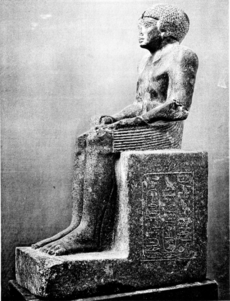
No priests from Sahure's funerary cult are known from the Middle Kingdom. However, evidence from this period comes from works done in the Karnak temple by 12th Dynasty pharaoh Senusret I. He dedicated statues of Old Kingdom kings, including one of Sahure. This statue and other royal portraits show that there was a general worship of royal ancestors.
The statue of Sahure, now in the Egyptian Museum in Cairo, is made of black granite and is 50 cm (20 inches) tall. Sahure is shown seated on a throne, wearing a pleated skirt and a curly wig. Inscriptions on the throne say it's a portrait of Sahure made by order of Senusret I.
Sahure's legacy was strong enough in the Middle Kingdom that he is mentioned in a story from the Westcar Papyrus. This papyrus tells a mythical story about the origins of the Fifth Dynasty, presenting Userkaf, Sahure, and Neferirkare Kakai as three brothers, sons of Ra.
New Kingdom: Sekhmet of Sahure
As a deceased king, Sahure continued to receive religious offerings in the New Kingdom as part of the worship of royal ancestors. For example, Sahure is on the Karnak king list, a list of kings carved on the walls of the Karnak temple. This list was for religious purposes, to honor deceased kings.
In the 18th and 19th Dynasties, many visitors left inscriptions and statues in Sahure's temple. These activities were linked to a cult that started in Sahure's temple during the time of Thutmose III. This cult was dedicated to the deified king in a form linked to the goddess Sekhmet, called "Sekhmet of Sahure."
For example, a scribe named Ptahemuia and other scribes visited Sahure's temple in the 30th year of Ramses II's reign (around 1249 BC). They asked Sekhmet to grant them a long life. We don't know why this cult appeared during the New Kingdom. However, the cult of Sekhmet of Sahure was not just a local thing. Traces of it were found in the village of Deir el-Medina, where it was celebrated during two festivals each year.
During the same period, Prince Khaemwaset, a son of Ramses II, worked on pyramids and temples across Egypt that had fallen into ruin. He might have been taking stones for his father's projects while doing some basic repairs for religious purposes. Inscriptions on Sahure's pyramid show that it was part of these works. This renewed attention also led to the first wave of taking apart monuments in Abusir, especially for valuable Tura limestone. Sahure's temple might have been spared then because of the Sekhmet cult. The cult's influence likely faded after Ramses II's reign, becoming a local worship site.
Later Periods: Third Intermediate, Late, and Ptolemaic
During the Twenty-fifth Dynasty (744–656 BC), some of Sahure's temple carvings were copied by Taharqa. These included images of the king defeating his enemies as a sphinx.
Soon after, under the Twenty-sixth Dynasty (664–525 BC), a statue of Sahure was found among other Old Kingdom king statues hidden in the Karnak temple. This shows that there was still some religious interest in him.
At the same time, a new period of taking apart the pyramids of Abusir began. But Sahure's pyramid was again spared. This might be because of the cult of Sekhmet of Sahure, which continued in the temple well into the Ptolemaic period (332–30 BC), though with less influence. Several graffiti from later reigns show continued religious activities at the site. For example, a man named Horib was "Priest of Sekhmet of the temple of Sekhmet of Sahure" during the Ptolemaic dynasty.
The serious dismantling of Sahure's pyramid began in the Roman period. This is shown by the many millstones, lime production facilities, and worker shelters found nearby.
Sahure in Modern Culture
Sahure’s name and his father’s name were used in the 1983 Sesame Street special Don't Eat the Pictures. A cursed child from ancient Egypt introduces himself as “Prince Sahure of Egypt, son of the god Userkof, king of kings, lord of the two lands, conquered of the east and west, and fabulous fisherman.”
See also
 In Spanish: Sahura para niños
In Spanish: Sahura para niños



